We’ve still yet to see a gaming GPU that supports PCIe 5.0, but that hasn’t stopped people working hard on not only this interface’s successor but the one that comes after it. The official first draft for version 0.5 the PCIe 7.0 spec has now been released, and the performance numbers inside it are astounding.
Even the best graphics cards around right now still only use the PCIe 4.0 interface, although plenty of the best gaming SSDs are now using the later PCIe 5.0 bus, and some of the best motherboards do come with a 16x PCIe 5.0 slot for future graphics cards as well. It’s fair to say that future graphics cards aren’t going to be held back by their interface, though, as PCIe 7.0 promises to be an incredibly quick bus.
The headline figure in the goals for the 0.5 spec, which has just been released to members of the PCI Special Interest Group (PCI-SIG) is a raw bit rate of 128GT/s (giga transfers per second) per lane. To put this figure into perspective, that’s 8x the speed of the PCIe 4.0 bus currently used by today’s graphics cards, such as the new Nvidia RTX 4080 Super.
Four PCIe 7.0 lanes would theoretically give you up to 64GB/s of bandwidth for the SSDs of tomorrow, realistically maxing out at 60.5GB/s in terms of throughput – that’s around four times the speed of the current fastest SSDs, such as the Crucial T705. I don’t even want to imagine the size of the heatsinks that would be required for them.
When it comes to GPUs, a 16x PCIe 7.0 slot would have 512GB/s of bi-directional bandwidth (256GB/s in a single direction) at its disposal for communication with the CPU, which realistically works out at 242GB/s in each direction when it comes to actual throughput – that bi-directional figure works out at 0.5TB/s, which is phenomenal speed for a component interconnect.
Putting that figure into perspective, you get 32GB/s in one direction from a 16x PCIe 4.0 slot (31.5GB/s actual throughput). The difference in the figures is incredible.
PCI-SIG says that PCIe 7.0 “remains on track for full release in 2025,” and has been publishing various iterations of the spec over the last few years to its members. Don’t worry about your motherboard quickly becoming out of date, though. The PCIe 6.0 spec was finalized back in 2022, but it still hasn’t made it into desktop PC components, and we don’t expect PCIe 7.0 to be a must-have feature for a good few years yet.
In the meantime, if you’re looking to put together a new rig based on the current PCIe 4.0 and PCIe 5.0 standards, check out our guide to the best gaming CPU, as well as our tutorial on how to build a gaming PC, where we take you through the whole process.
